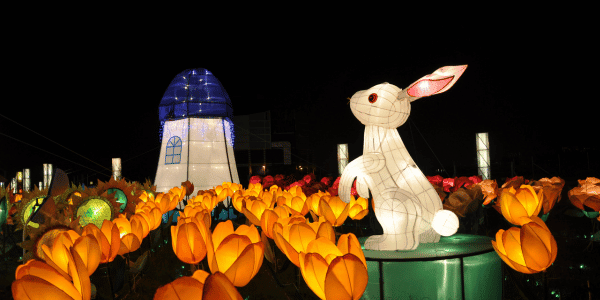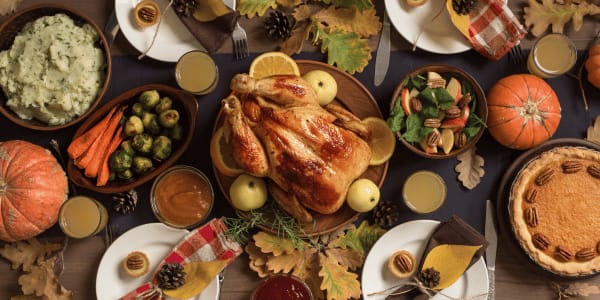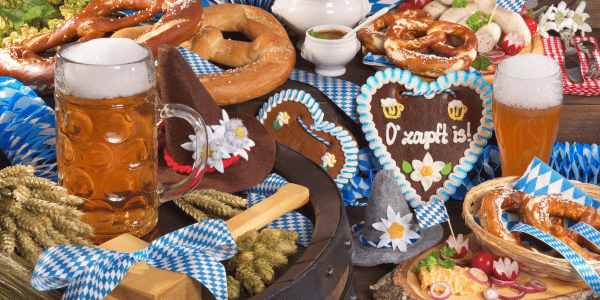Fun Fall Holidays to Celebrate This Year
As hot summer days are replaced by brisk, cool mornings, fall is slowly casting its spell on us. With the leaves dancing in the wind, breeze brushing against your arm, and woodsy smell permeating the air, autumn’s natural wonders captivate the senses while generating excitement for what’s to come. Playing host to some of the most cherished celebrations, fall’s magic lies in the traditions, reflection, and joy illuminated through each occasion. Follow along as we highlight a few spirited fall holidays and all the hocus-pocus surrounding them.
Mid-Autumn Festival: What is Mid-Autumn Festival?

The Mid-Autumn Festival, Moon Festival, or Mooncake Festival is a Chinese and East Asian harvest festival focused on the moon. Held on the 15th day of the eighth month of the lunar calendar—usually in late September or early October—the Mid-Autumn Festival takes place when the moon is thought to shine the brightest. With history tracing back over 3,000 years, the Mid-Autumn Festival is about reuniting with family, showing thanks, and appreciating the moon, which represents completeness and togetherness.
It all started with ancient Chinese emperors worshiping the moon every mid-Autumn, hoping it would bring a bountiful harvest. Their ways spread far and wide, and the Mid-Autumn Festival became an official holiday in the Song Dynasty (960-1279). Other myths, including the Legend of Chang’e, are also linked to the celebration.
Tales reveal that Hou Yi, the husband of Chang’e, the Chinese lunar goddess, received an immortality elixir as a reward for shooting down nine suns, saving the earth from being burnt to a crisp. Chang’e was forced to take the elixir amid an encounter with evil spirits, and she floated up to the moon and remained there forever. Hou Yi’s ritual of making offerings to Chang’e stuck around, and his sacrifices to the moon embody the central theme of family unity. Today, people in many Asian countries spend the Mid-Autumn Festival gathering with loved ones, giving gifts, making and hanging colorful lanterns, eating mooncakes, and gazing at the moon’s beauty.
How to Celebrate Mid-Autumn Festival:
- Burn incense
- Display lanterns
- Drink Osmanthus wine
- Eat mooncakes
- Admire the moon with friends and family
- Watch tai chi exhibitions
Oktoberfest: What is Oktoberfest?
Oktoberfest is a two-week folk festival in Munich, Germany, that kicks off in September and ends on the first Sunday in October. While Oktoberfest is now the largest global event where visitors can immerse themselves in Bavarian culture and, of course, beer, it didn’t start that way.
The excitement began on October 12, 1810, to commemorate the marriage of the crown prince of Bavaria (later King Ludwig I) to Princess Therese von Sachsen-Hildburghausen. The couple invited about 40,000 citizens to participate in the revelry, which featured a massive feast and horse races. In 1811, the race was held again, but it was combined with a state agricultural fair to draw more attendees and attention. In 1818, carnival rides, food, and hallmark beer stalls were added to the racing event. Eventually, the phenomenon became an annual happening; it was lengthened and pushed to September, so the weather was warmer.
Two hundred years later, the iconic spectacle still occurs. Over six million people flock to Germany each fall and consume over seven million liters of beer. But you don’t have to travel to Europe to drink from a stein, dance to folk music, and catch people in lederhosen and dirndls. The appeal of the most popular party has spread, and thousands of cities host their own Oktoberfest to indulge in German customs, bring friends together, and let the good times roll.
How to Celebrate Oktoberfest:
- Listen to traditional oompah music
- Wear lederhosen and dirndls
- Eat pretzels, bratwurst, sauerkraut, potato salad, and schnitzel
- Go to a local Oktoberfest celebration
- Drink a German beer, like Märzen, Hefeweizen, or Pilsner
- Host a beer stein relay race or yodeling contest
Related Content: Beer Decoded: Understanding the Basics
Canadian Thanksgiving: What is Canadian Thanksgiving?

Canadian Thanksgiving is a revered national holiday made for being with friends and family, saying “thank you,” and eating delicious fall foods. Although the modern event is very similar to the American Thanksgiving, the cause is slightly different—and it predates the first American Thanksgiving by 43 years.
While Indigenous people in Canada have long had traditions of giving thanks for receiving crops and surviving winter, the first recorded Canadian Thanksgiving dinner was held by English sailor Sir Martin Frobisher and his crew in 1578. They ate a meal of salted beef, biscuits, and mushy peas to celebrate safely arriving in what’s now Nunavut, Canada’s biggest and northernmost territory. Moving forward, festivities were hosted sporadically to express gratitude for the protection of explorers as they journeyed to the New World. Over time, the fêtes grew to also show appreciation for a generous fall harvest, and Thanksgiving became a holiday on November 6, 1879.
In 1957, Parliament changed the date to the second Monday in October to distance it from American Thanksgiving and better align with the conclusion of the harvest season. Now, Canadians enjoy football and the classic fare, like turkey, mashed potatoes, stuffing, and other seasonal foods; however, their Thanksgiving is more low-key than American Thanksgiving. It isn’t celebrated in all parts of Canada, and companies aren’t required to give employees the day off.
How to Celebrate Canadian Thanksgiving:
- Watch the Canadian Football League’s Thanksgiving Day Classic
- Stream the Kitchener-Waterloo Oktoberfest Thanksgiving Day Parade
- Eat a Jiggs dinner with boiled pea pudding, corned beef, and root vegetables
- Gather with friends and family
- Give thanks for good fortunes from the previous year
- Bake butter tarts
Related Content: How to Make the Perfect Thanksgiving Turkey
Halloween: What is Halloween?

Happening on October 31, Halloween is a beloved spooky day—and one of the oldest traditions in the world. According to some legends, the Celts, who lived in what’s now Ireland, the United Kingdom, and northern France, pioneered the festival over 2,000 years ago. The initial observance, Samhain, served as their New Year’s Eve, the end of summer, and the beginning of winter.
During Samhain, people believed the veil between the living and dead was its thinnest, allowing spirits to enter our realm easily. Celebrants would light bonfires to ward off ghosts, wear costumes and masks to fool them, and leave small, sweet offerings outside their doors to appease them (sound familiar?).
Centuries later, Christianity extended to Celtic territories, and the Celtic New Year on November 1 was replaced with All Saints’ Day or All Hallows’ Day. The night before—originally Samhain—became All Hallows’ Eve, ultimately shortening to Halloween. When Scottish and Irish immigrants came to North America in the 1800s, they brought the holiday and its shenanigans. Their Halloween practices meshed with those of other ethnic groups and evolved into the commercial affair we know today.
How to Celebrate Halloween:
- Decorate with bats, spider webs, skeletons, witches, and ghosts
- Carve pumpkins
- Go trick-or-treating
- Dress up in a costume
- Watch a scary movie
- Bob for apples
Related Content: 6 Pumpkin-Carving Tips for Halloween
Diá de los Muertos: What is Diá de los Muertos?

The Day of the Dead, or Diá de los Muertos in Spanish, is a holiday near Halloween where people gather to remember and pay respects to friends and family members who have died. Beginning in Central Mexico, the Day of the Dead is said to have been embedded in rituals honoring the departed in pre-Columbian Mesoamerica. In Aztec culture, death was a phase in life in which the soul left but returned when invited back to the living world, sharing in the joy of being reunited with friends and family.
The event looks unique everywhere but often includes decorating the gravesite of the deceased and creating an altar for them at home. Offerings, called ofrendas, are left at these places to honor the dead and invite them back. You might see photos, candles, bread, salt, colorful marigolds, and the deceased person’s favorite foods, drinks, and other items. Additionally, some cities hold parades that start at a cemetery and end at a church, concluding with a festival. People may also don masks or face paint depicting a sugar skull, called a calavera, and dress up.
A celebratory occasion, the Day of the Dead is meant to be happy and fun. It’s when the boundary between the spirit world and the real world disappears, and the dead are welcomed to eat, drink, and be merry.
How to Celebrate Day of the Dead:
- Host a feast with traditional Mexican stews, like Pozole and Mole
- Bake Mexican sweet bread (pan de muerto)
- Make sugar skulls
- Watch Coco
- Visit the gravesite of a loved one
- Share stories of those who passed
Diwali: What is Diwali?

Around October and November, Hindus, Sikhs, Jains, and Buddhists across the globe observe Diwali. Derived from the Sanskrit term “Deepavali,” meaning “row of lights,” Diwali is also known as the Festival of Lights.
With roots over 2,500 years old, its exact origins are unclear, and various religions, regions, and cultures put their own emphasis and touch on celebrations and stories. Some say Diwali commemorates the return of Prince Rama of Ayodhya, his wife Sita, and brother Lakshman after a 14-year exile. Others say Diwali is the day Lord Krishna defeated the demon Narakasura. And in different areas, Diwali is associated with Lakshmi, the goddess of prosperity and wealth. Regardless, most agree that Diwali symbolizes the victory of light over darkness, good over evil, and knowledge over ignorance.
Each day of Diwali has its own significance and customs. The first day is typically dedicated to wealth and prosperity, and it is good luck to clean your home and buy gold, silver, or new utensils. On the second day, people have small events and decorate their homes with rangoli designs and candles, lanterns, and diyas (oil lamps).
The third day is the main celebration, and people say prayers, host feasts, and set off fireworks. The fourth signifies the first day of the New Year in many parts of India, and people visit relatives and send well wishes. The final day is for the bonds between siblings, and brothers and sisters exchange gifts and eat lavish meals. Overall, Diwali’s rich history is a demonstration of tradition and goodness.
How to Celebrate Diwali:
- Wish someone a Happy Diwali by saying “Shub Deepavali” or “Diwali ki hardik Shubkamnaye”
- Wear new clothes
- Clean and declutter your home
- Decorate with lights, candles, and lanterns
- Eat treats and snacks like ladoos and samosas
- Set off fireworks
Beyond Fall Holidays: More Autumn Adventures
Now that you know so much about the holidays in the fall and fall festivities, you have plenty to explore, but we have even more options for you to enjoy! In our “Autumn Adventures” article, you can find 99 fall bucket list ideas to cross off in September, October, and November. From cool outings and new adventures abroad to exciting discoveries you can make at home, get a month-to-month guide for enjoying autumn to the fullest extent.
